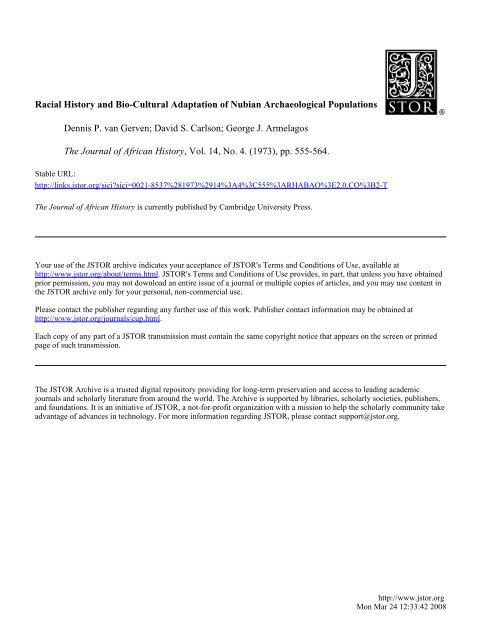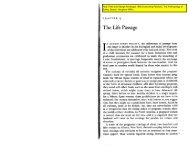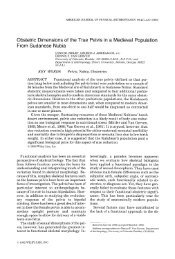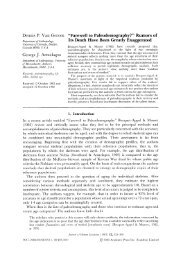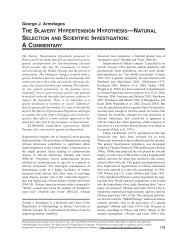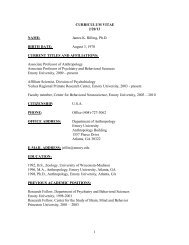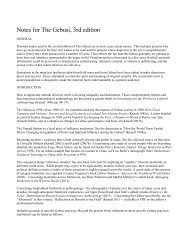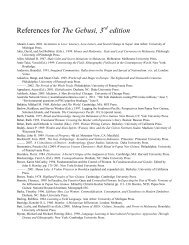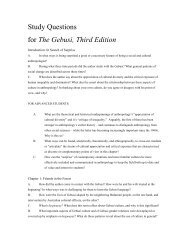Racial History and Bio-Cultural Adaptation of Nubian ... - Anthropology
Racial History and Bio-Cultural Adaptation of Nubian ... - Anthropology
Racial History and Bio-Cultural Adaptation of Nubian ... - Anthropology
You also want an ePaper? Increase the reach of your titles
YUMPU automatically turns print PDFs into web optimized ePapers that Google loves.
<strong>Racial</strong> <strong>History</strong> <strong>and</strong> <strong>Bio</strong>-<strong>Cultural</strong> <strong>Adaptation</strong> <strong>of</strong> <strong>Nubian</strong> Archaeological Populations<br />
Dennis P. van Gerven; David S. Carlson; George J. Armelagos<br />
The Journal <strong>of</strong> African <strong>History</strong>, Vol. 14, No. 4. (1973), pp. 555-564.<br />
Stable URL:<br />
http://links.jstor.org/sici?sici=0021-8537%281973%2914%3A4%3C555%3ARHABAO%3E2.0.CO%3B2-T<br />
The Journal <strong>of</strong> African <strong>History</strong> is currently published by Cambridge University Press.<br />
Your use <strong>of</strong> the JSTOR archive indicates your acceptance <strong>of</strong> JSTOR's Terms <strong>and</strong> Conditions <strong>of</strong> Use, available at<br />
http://www.jstor.org/about/terms.html. JSTOR's Terms <strong>and</strong> Conditions <strong>of</strong> Use provides, in part, that unless you have obtained<br />
prior permission, you may not download an entire issue <strong>of</strong> a journal or multiple copies <strong>of</strong> articles, <strong>and</strong> you may use content in<br />
the JSTOR archive only for your personal, non-commercial use.<br />
Please contact the publisher regarding any further use <strong>of</strong> this work. Publisher contact information may be obtained at<br />
http://www.jstor.org/journals/cup.html.<br />
Each copy <strong>of</strong> any part <strong>of</strong> a JSTOR transmission must contain the same copyright notice that appears on the screen or printed<br />
page <strong>of</strong> such transmission.<br />
The JSTOR Archive is a trusted digital repository providing for long-term preservation <strong>and</strong> access to leading academic<br />
journals <strong>and</strong> scholarly literature from around the world. The Archive is supported by libraries, scholarly societies, publishers,<br />
<strong>and</strong> foundations. It is an initiative <strong>of</strong> JSTOR, a not-for-pr<strong>of</strong>it organization with a mission to help the scholarly community take<br />
advantage <strong>of</strong> advances in technology. For more information regarding JSTOR, please contact support@jstor.org.<br />
http://www.jstor.org<br />
Mon Mar 24 12:33:42 2008
Journal <strong>of</strong> Africatz <strong>History</strong>, XIV, 4 (1973), pp. 555-564<br />
Printed in Great Britain<br />
RACIAL HISTORY -4ND BIO-CULTURAL<br />
ADAPTATION OF<br />
NUBIAN ARCHAEOLOGICAL POPULATIONS<br />
BY DENNIS P. VAN GERVEN, DAVID S. CARLSON,<br />
AND GEORGE J. ARMELAGOS<br />
TRADITIONALLY a principal role <strong>of</strong> the physical anthropologist has been<br />
the analysis <strong>of</strong> human skeletal remains. Oftentimes, in order to stimulate<br />
interest in saving skeletal materials, physical anthropologists have incorrectly<br />
proposed that they could provide information toward the<br />
historical reconstruction <strong>of</strong> cultural traditions through the analysis <strong>and</strong><br />
classification <strong>of</strong> skeletal material. Such analyses have consistently utilized<br />
similarities in skeletal morphology <strong>and</strong> hypothetical racial affinities to<br />
establish biological relationships between skeletal series. Such relationships,<br />
once established, have then been assumed to reflect the degree to<br />
which populations are culturally related.<br />
The analysis <strong>of</strong> the skeletal remains <strong>of</strong> <strong>Nubian</strong> archaeological populations<br />
has played a major role in the development <strong>of</strong> this tradition. This has<br />
largely been due to Nubia's unique geographical <strong>and</strong> cultural relationship<br />
to both sub-Saharan Africa <strong>and</strong> the Mediterranean.<br />
For all its innate poverty, Nubia has played a significant <strong>and</strong> at times decisive<br />
role in the culture history <strong>of</strong> East Africa, for the Nile Valley has provided, since<br />
the dawn <strong>of</strong> history, the only permanent connecting link between the ancient<br />
centres <strong>of</strong> Mediterranean civilization <strong>and</strong> the cultures <strong>of</strong> sub-Saharan Africa.<br />
As a result the peoples <strong>and</strong> cultures <strong>of</strong> Nubia are neither wholly Mediterranean<br />
nor wholly African: since earliest times they have presented a unique blend <strong>of</strong><br />
the tw0.l<br />
Elliot-Smith, Douglas Derry, <strong>and</strong> F. Wood Jones began the systematic<br />
analysis <strong>of</strong> <strong>Nubian</strong> skeletal material shortly after the beginning <strong>of</strong> the<br />
present century. Studying the material collected by the first Archaeological<br />
Survey <strong>of</strong> Nubia (1907-1 I), they believed that they had found important<br />
'racial differences' in the <strong>Nubian</strong> populations at different times in history,<br />
most <strong>of</strong> which they expressed in terms <strong>of</strong> differing degrees <strong>of</strong> 'Negroid<br />
admixt~re'.~ In keeping with the prevalent racial ideology <strong>of</strong> their times,<br />
these differences in turn were held to account for significant cultural<br />
changes in <strong>Nubian</strong> history. Periods <strong>of</strong> cultural advance or enrichment were<br />
attributed to Caucasian migrations; 'dark ages' were the result <strong>of</strong> Negroid<br />
migrations.<br />
The intellectual commitment to biological determinism associated<br />
W. Y. Adams, 'Continuity <strong>and</strong> change in <strong>Nubian</strong> culture history', Sudan Notes <strong>and</strong><br />
RCCOY~S, XLVIII (1967), 1-32.<br />
G. Elliot-Smith <strong>and</strong> F. Wood Jones, 'Report <strong>of</strong> the human remains', The Archaeological<br />
Survey <strong>of</strong> Nubia, Report for 1907-1908, 11 (I~IO),Cairo.
556<br />
D. P. VAN GERVEN, D. S. CARLSON, AND G. J. ARMELAGOS<br />
with these early researches into the history <strong>of</strong> Egypt <strong>and</strong> Nubia did not go<br />
uncriticized. In 1905 Myers pointed out that there u-ere significant<br />
statistical errors due to poor sampling <strong>and</strong> a lack <strong>of</strong> underst<strong>and</strong>ing <strong>of</strong> the<br />
biological processes relevant to human ariat ti on.^ This criticism was<br />
exp<strong>and</strong>ed to include the entire concept <strong>of</strong> race as it was being applied to<br />
skeletal populations. However, in spite <strong>of</strong> these criticisms, anthropometric<br />
analyses <strong>of</strong> Egypt <strong>and</strong> Nubia continued to be a major focus for physical<br />
anthropologists as well as statisticians.<br />
Ahmed Batrawi, who studied the collections from the second Archaeo-<br />
logical Survey <strong>of</strong> Nubia (1929-34), initially endorsed the conclusions <strong>of</strong><br />
Elliot-Smith <strong>and</strong> co-workers,* although at a later date he modified his<br />
position considerably. At that time he wisely observed that:<br />
.. .failure to distinguish clearly between the achievements <strong>of</strong> populations <strong>and</strong><br />
their inherent biological characteristics has caused much confusion in anthro-<br />
pological writing. The literature dealing with the racial history <strong>of</strong> Egypt [<strong>and</strong><br />
Nubia] provides an outst<strong>and</strong>ing example <strong>of</strong> the danger <strong>of</strong> assessing biological<br />
relationships from cultural evidence.j<br />
While Batrawi's rejection <strong>of</strong> a causal link between race <strong>and</strong> cultural<br />
achievement is to be commended, his approach to biological variation<br />
remained tied to the traditional concepts <strong>of</strong> typology <strong>and</strong> their relevance<br />
to questions <strong>of</strong> racial <strong>and</strong> cultural history. The three most central features<br />
<strong>of</strong> this approach continued to be: (I) a basic orientation toward typological<br />
definition <strong>and</strong> description, (2) a dependence upon admixture (gene flow)<br />
as an explanatory model, <strong>and</strong> (3) a commitment to the objective reality <strong>of</strong><br />
the racial type, <strong>and</strong> the utility <strong>of</strong> such concepts as hybrid <strong>and</strong> atavism in<br />
the reconstruction <strong>of</strong> racial history.<br />
Although the limitations inherent in this approach are well known, they<br />
continue to dem<strong>and</strong> our consideration. While physical anthropology has<br />
advanced greatly in scope <strong>and</strong> technique, typological description has re-<br />
mained central to much <strong>of</strong> the theoretical outlook <strong>and</strong> problem orientation<br />
<strong>of</strong> physical anthropology in Nubia. This has resulted principally from a<br />
continuing concern for the history <strong>of</strong> racial admixture <strong>and</strong> its relationship<br />
to cultural development in Egypt <strong>and</strong> Nubia. As a consequence, the<br />
development <strong>of</strong> alternative approaches has been extremely limited.<br />
In arguing for a post-paleolithic Negroid admixture in Nubia, Strouhal<br />
stated that 'modern genetically orientated studies, e.g. <strong>of</strong> the blood<br />
groups, show the penetration <strong>of</strong> the Egyptian population by Negro<br />
gene^.'^ Such a statement is no less limiting than Batrawi's earlier morpho-<br />
C. S. Myers, 'Contributions to Egyptian <strong>Anthropology</strong>: 11. The comparative anthropometry<br />
<strong>of</strong> the most ancient <strong>and</strong> modern inhabitants', J.R.A.Z.,xxxv (rgog), 80-91.<br />
A. M. Batrawi, . 'Report . on the human remains, mission archaeologique de Nubie',<br />
Cairo: Government Press (1935).<br />
A. M. Batrawi, 'The racial history <strong>of</strong> Egypt <strong>and</strong> Nubia: 11', J.R.A.Z.,LXXVI (1946),<br />
131-j6.<br />
E. Strouhal, 'Evidence <strong>of</strong> the early penetration <strong>of</strong> Negroes into prehistoric Egypt',<br />
J'. Afr. Hist., XII (1971)~ 1-9.
NUBIAN ARCHAEOLOGICAL POPULATIONS 5 57<br />
logical typology. Once a feature, morphological or genetic, is defined as<br />
representing a specific racial type, the only possible explanation for its<br />
occurrence in additional populations is admixture resulting from migration.<br />
Such a view improperly portrays human populations as internally static<br />
units changing only as a function <strong>of</strong> external forces, i.e. genetic flow.<br />
In attempting to determine the time at which Negroid admixture<br />
occurred in Nubia, Strouhal analysed 177 Badarian crania. The crania<br />
were suggested to represent the oldest known culture <strong>of</strong> settled farmers<br />
<strong>and</strong> pastoralists <strong>of</strong> Upper Egypt (about 4000 B.c.). While temporally<br />
separated from Batrawi's analysis by thirty-six years, the approach <strong>of</strong><br />
Strouhal is still essentially typological.<br />
The majority <strong>of</strong> 94 skulls showed mixed Europoid-Negroid features. . . . In<br />
one third <strong>of</strong> them the Europoid, in the other third the Negroid, features were<br />
dominant. The last third showed both components, either well-balanced or with<br />
characters <strong>of</strong> the neutral range common to both racial group^.^<br />
Such an assumption <strong>of</strong> the atavistic reappearance <strong>of</strong> racial types has no<br />
acceptable basis today.<br />
The hybridization <strong>of</strong> unlike human groups has still other genetic implications<br />
which bear on problems <strong>of</strong> historical reconstruction. An investigator is easily<br />
trapped into circular reasoning if he surmises that types can usefully be defined<br />
as polar, that they once predominated in the ancestors <strong>of</strong> a living group, <strong>and</strong><br />
that their occurrence today constitutes the atavistic reappearance <strong>of</strong> such ances-<br />
tors.8<br />
Even if the constellation <strong>of</strong> traits defining a racial type were demonstrably<br />
linked, which they are not, the type would only persist through generations<br />
to the extent selective mechanisms acted to favour it.<br />
Unless selection favors the persistence <strong>of</strong> ancestral combinations <strong>of</strong> genes,<br />
carriers <strong>of</strong> these complexes should appear among the hybrids no more <strong>of</strong>ten<br />
than one might expect by chance. In other words, panmixia should scatter<br />
the ancestral alleles separately <strong>and</strong> r<strong>and</strong>omly throughout the membership <strong>of</strong> a<br />
hybrid population.<br />
Burnor <strong>and</strong> Harris, while suggesting Negroid-Caucasoid admixture at<br />
a much earlier Pleistocene date, approach the problem <strong>of</strong> <strong>Nubian</strong> racial<br />
history in a manner similar to Strouhal.l0 The authors hypothesize that<br />
in Pleistocene times, Capoid populations (that is, physically similar to<br />
the peoples speaking Khoisan languages in present-day southern Africa)<br />
inhabited the shores <strong>of</strong> the Mediterranean. About 14,000 years ago these<br />
peoples :<br />
. . . moved to South Africa via the East African highl<strong>and</strong>s due to pressure<br />
' Ibid.<br />
E. E. Hunt, 'Anthropometry, genetics, <strong>and</strong> racial history', American Anthropologist,<br />
LXI (19591, 64-87. Ibid.<br />
D. R. Burnor <strong>and</strong> J. E. Harris, '<strong>Racial</strong> continuity in Lower Nubia: 12,ooo B.C. to<br />
the present', Proc. Indiana Acad. Sci. for 1967, LXXVII(1968), 113-21.
exerted upon them by the invading Caucasoids, <strong>and</strong> in so doing, they displaced<br />
or absorbed various Congoid populations that were more primitive than them-<br />
selves.ll<br />
Although the authors view the <strong>Nubian</strong> population as having remained<br />
stable over the last several thous<strong>and</strong> years, they propose that the living<br />
<strong>Nubian</strong>s are the result <strong>of</strong> the massive penetration <strong>of</strong> Negroid Africa by<br />
Caucasoid genes during the last 14,000 years. In support <strong>of</strong> this hypothesis,<br />
the skeletal remains <strong>of</strong> a <strong>Nubian</strong> Mesolithic population are described as<br />
possessing bun-shaped occiputs, massive browridges, sloping foreheads,<br />
extreme facial flattening, large teeth <strong>and</strong> deep m<strong>and</strong>ibles. This <strong>and</strong> other<br />
evidence is proposed to indicate that Africa, north <strong>of</strong> the Sahara, was<br />
originally inhabited by non-Caucasoid populations that can in general be<br />
termed Negroid.<br />
There are several points at which this analysis remains essentially<br />
typological. Specifically, Greene pointed out in his discussion <strong>of</strong> racial<br />
reconstructions :<br />
If indeed there were adequate models for the presumed Negro race <strong>of</strong> Africa<br />
that existed thous<strong>and</strong>s <strong>of</strong> years ago, then this approach has validity. However,<br />
it can be contended that such models are at present not valid since there is<br />
little evidence for reconstructing what the then contemporary African Negroes<br />
were like skeletally. One can only extrapolate from modern Negroes who may<br />
not at all be like their ancestory since racial groups are not static, but evolve.12<br />
In addition, many <strong>of</strong> the skeletal features listed separately by Burnor<br />
<strong>and</strong> Harris may, in fact, be related functionally <strong>and</strong>/or epigenetically.<br />
Greene <strong>and</strong> co-workers have suggested that features such as large complex<br />
tooth form, glabellar protrusion, gonial eversion <strong>and</strong> massive m<strong>and</strong>ible<br />
are all indicative <strong>of</strong> heavy masticatory masculature.13 Such features in the<br />
<strong>Nubian</strong> Mesolithic population are similar to those represented by the<br />
Ne<strong>and</strong>erthal remains at the Skuhl site in Israel <strong>and</strong> also by contemporary<br />
aboriginal Australian populations. Such commonality suggests similar<br />
adaptation rather than common racial origin <strong>and</strong> migration.<br />
Once again, the explanation <strong>of</strong> morphological similarity between two<br />
populations in terms <strong>of</strong> racial origins <strong>and</strong> affinities is totally inadequate<br />
unless the role played by natural selection <strong>and</strong> possible parallel evolution<br />
has been determined <strong>and</strong> incorporated into the analysis.<br />
Berry <strong>and</strong> co-workers have reviewed arguments concerning racial<br />
affinities <strong>and</strong> admixture <strong>of</strong> prehistoric groups in Nubia, <strong>and</strong> have been<br />
critical <strong>of</strong> the racial approach which has been so characteristic <strong>of</strong> studies<br />
<strong>of</strong> <strong>Nubian</strong> <strong>and</strong> Egyptian prehistory.14 They suggest that research should<br />
l1 Ibid.<br />
l2D. L. Greene, 'Dental anthropology <strong>of</strong> early Egypt <strong>and</strong> Nubia', J. Human Evolution,<br />
L (19721, 315-24.<br />
'3 D. L. Greene, G. H. Ewing <strong>and</strong> G. J. Armelagos, 'Dentition <strong>of</strong> a Mesolithic popula-<br />
tion from Wadi Halfa, Sudan', Am. J. Phys. Anthrop., XXVII (1967), 41-55<br />
l4 A. C. Berry, R. J. Berry <strong>and</strong> P. J. Ucko, 'Genetical change in ancient Egypt', Man,<br />
11 (1967), j51-68.
NUBIAN ARCHAEOLOGICAL POPULATIONS 559<br />
be directed away from morphological studies toward the analysis <strong>of</strong> dis-<br />
crete cranial traits in establishing population relationships through time.<br />
Although there has been considerable criticism <strong>of</strong> the use <strong>of</strong> discrete<br />
traits in measuring biological distance between groups, there remains little<br />
question that the use <strong>of</strong> non-continuous variables represents a more solid<br />
approach to the study <strong>of</strong> genetic relationships between populations. This is<br />
not to suggest that discrete traits will, without question, determine genetic<br />
affinities, but merely that such traits are less likely to be functionally<br />
significant <strong>and</strong> therefore more likely to appear as a result <strong>of</strong> genetic<br />
structure than analogy. The influence <strong>of</strong> development upon the appearance<br />
<strong>of</strong> discrete traits, however, remains to be determined. There is some<br />
evidence that the asymmetry <strong>of</strong> these traits is a result <strong>of</strong> a breakdown in<br />
homeostatic (physiological regulatory) mechanisms, which implies that<br />
the appearance <strong>of</strong> discrete traits may be intimately related to non-geneti-<br />
cally determined (canalized) development.15 Thus, the appearance <strong>of</strong><br />
discrete skeletal traits may be as much a function <strong>of</strong> non-genetic factors<br />
as genetic factors. For this reason, the use <strong>of</strong> discrete traits to obtain<br />
genetic differences or similarities may not be as useful as many researchers<br />
believe, <strong>and</strong> should be approached with caution.<br />
MacGaffey has recently provided an interesting interpretation <strong>of</strong> why<br />
students <strong>of</strong> <strong>Nubian</strong> physical anthropology have continued to maintain a<br />
racial approach in spite <strong>of</strong> the apparent biological inconsistencies involved.<br />
MacGaffey suggests that such studies have their roots deep within the<br />
structure <strong>and</strong> philosophy <strong>of</strong> Western civilization, <strong>and</strong> 'call for an ideology<br />
which sanctions as natural <strong>and</strong> necessary a polarization <strong>of</strong> rulers <strong>and</strong> the<br />
ruled, the bearers <strong>and</strong> receivers <strong>of</strong> culture'.16 In Nubia, these studies begin<br />
with the a priori assumption that there were two basic groups, or types,<br />
which occupied Africa early in its prehistory, <strong>and</strong> that any biological <strong>and</strong>/<br />
or cultural deviations from these idealized types represent a mixture, or a<br />
hybridization, <strong>of</strong> the two. Thus MacGaffey suggests the culture history<br />
<strong>of</strong> Nubia has been explained in terms <strong>of</strong> type, hybridization, <strong>and</strong> atavism<br />
rather than the more biologically <strong>and</strong> culturally meaningful units <strong>of</strong><br />
variation, evolution <strong>and</strong> development.<br />
The very qualities <strong>of</strong> preservation <strong>and</strong> cultural context which excited<br />
traditional interests in <strong>Nubian</strong> skeletal remains provide an almost unique<br />
potential for developing the alternatives suggested by MacGaffey. This<br />
has resulted principally from recent growth in the archaeological record<br />
such that it is no longer necessary to rely upon hypothetical racial constructs<br />
to aid in the analysis <strong>of</strong> culture history.<br />
The International Campaign to Save the Monuments <strong>of</strong> Nubia, begun<br />
in 1960, provided not only new insight into the history <strong>of</strong> the <strong>Nubian</strong><br />
l6 W. L. Howe <strong>and</strong> P. A. Parsons, 'hforphogenetic homeostasis in man', Acta Gen.<br />
Stat. -&fed., XVIII (1968), 341-8.<br />
l6W. MacGaffey, 'Concepts <strong>of</strong> race in the historiography <strong>of</strong> Northeast Africa', r.Afr.<br />
Hist., VII (1966), 1-17.
corridor <strong>and</strong> its relationship to sub-Saharan Africa <strong>and</strong> the Mediterranean,<br />
but re-established a productive relationship between the archaeology <strong>and</strong><br />
physical anthropology <strong>of</strong> the area. Analyses resulting from the campaign<br />
failed to support earlier interpretations <strong>of</strong> <strong>Nubian</strong> history as a series <strong>of</strong><br />
disconnected episodes each resulting from the arrival <strong>of</strong> new populations.<br />
Thus we know, or should know, today that we must consider <strong>and</strong> explore<br />
separately the changes in culture, language, <strong>and</strong> population which have taken<br />
place in the course <strong>of</strong> <strong>Nubian</strong> history. So far as population is concerned, we<br />
have, notwithst<strong>and</strong>ing earlier theories, no reliable evidence <strong>of</strong> any major or<br />
complete changes during the whole historic period. In the absence <strong>of</strong> such<br />
evidence, <strong>and</strong> in view <strong>of</strong> the obvious social <strong>and</strong> cultural continuity between<br />
most <strong>of</strong> the <strong>Nubian</strong> cultural phases, we must now adopt as a working hypothesis<br />
the idea that the <strong>Nubian</strong> population has remained basically the same since<br />
Neolithic times.17<br />
Adams has proposed further that we regard the course <strong>of</strong> <strong>Nubian</strong><br />
culture history from Neolithic to Islamic as a continuum <strong>of</strong> cultural <strong>and</strong><br />
social development involving three basic stages.<br />
These may, for the time being, be designated as Archaic, Dynastic, <strong>and</strong> Medieval.<br />
The first includes the Shaheinab, A-Group, <strong>and</strong> C-Group phases, the second<br />
the Pharaonic, Napatan, Meroitic <strong>and</strong> X-Group, <strong>and</strong> the third the Christian<br />
<strong>and</strong> Islamic periods.ls<br />
This basic reorientation has provided the necessary context for a bio-<br />
cultural approach to the skeletal biology <strong>of</strong> <strong>Nubian</strong> populations. Such an<br />
approach views the variation in human populations as dependent upon<br />
the action <strong>of</strong> environmental agencies both mediated by <strong>and</strong> resulting from<br />
patterns <strong>of</strong> cultural adaptation. The role <strong>of</strong> the physical anthropologist<br />
should, therefore, be to determine the impact <strong>of</strong> <strong>Nubian</strong> cultural develop-<br />
ment on the biology <strong>of</strong> the populations involved. Such an approach<br />
broadens the scope <strong>of</strong> anthropological inquiry rather than perpetuating<br />
the limitations inherent in racial history as an adjunct to archaeological<br />
investigation.<br />
Armelagos <strong>and</strong> co-workers have recently analysed skeletal remains<br />
excavated from cemeteries associated with Meroitic, X-Group <strong>and</strong><br />
Christian cultural horizons in the Wadi Halfa area <strong>of</strong> Lower Nubia. By<br />
focusing on patterns <strong>of</strong> mortality, bone growth <strong>and</strong> development, <strong>and</strong><br />
pathology, the results <strong>of</strong> their analyses have contributed substantially to<br />
our underst<strong>and</strong>ing <strong>of</strong> <strong>Nubian</strong> history from a bio-cultural perspective.<br />
The analysis <strong>of</strong> mortality pr<strong>of</strong>iles based on a large series <strong>of</strong> skeletons<br />
from a Christian cemetery at the site <strong>of</strong> Meinarti, provided an independent<br />
source <strong>of</strong> information relevant to the culture history <strong>of</strong> the area. According<br />
to Adams, occupation <strong>of</strong> the site could be divided into two periods on<br />
l7 W. Y. Adams, 'Continuity <strong>and</strong> change in Nubia'.<br />
l8 Ibid.
NUBIAN ARCHAEOLOGICAL POPULATIONS 561<br />
archaeological grounds.lg* 20 Based on architectural expansion <strong>of</strong> the<br />
village, the earlier period (A.D. ~ojo-1150)was one <strong>of</strong> growth, while the<br />
later period (A.D. I I50-1300)was one <strong>of</strong> decline, with ab<strong>and</strong>onment <strong>of</strong> the<br />
village by A.D. 1300.<br />
The results obtained from calculating life tables for each <strong>of</strong> the two<br />
periods provided a concise summary <strong>of</strong> the mortality characteristics <strong>of</strong> the<br />
Meinarti population. The results directly support Adams's interpretation<br />
based on archaeological investigation. When life tables were compared<br />
for the two periods, a definite trend was noted. During the period <strong>of</strong><br />
village decline, life expectancy was consistently lower <strong>and</strong> the probability<br />
<strong>of</strong> dying was greater in every age interval.21<br />
A more general analysis <strong>of</strong> mortality patterns based on survival curves from<br />
Meroitic, X-Group <strong>and</strong> Christian samples revealed, according to Armelagos :<br />
. . . both general <strong>and</strong> specific survival patterns comparable to those <strong>of</strong> other<br />
populations. For example, the Meroitic, X-Group <strong>and</strong> Christian samples all<br />
demonstrated the classic survival curve characteristics <strong>of</strong> an agricultural society.<br />
Mortality was high among infants, levelled <strong>of</strong>f slightly among young adults, <strong>and</strong><br />
increased sharply among older adults.22<br />
Beyond these general trends, a comparison <strong>of</strong> Meroitic, X-Group <strong>and</strong><br />
Christian horizons revealed changes in survival patterns corresponding to<br />
changes in cultural stress associated with the rise <strong>and</strong> decline <strong>of</strong> the Meroitic<br />
empire <strong>and</strong> the later adoption <strong>of</strong> Chri~tianity.~~<br />
In addition to the analysis <strong>of</strong> mortality, we have attempted to utilize<br />
the same materials to aid in elucidating processes <strong>of</strong> bone growth <strong>and</strong><br />
development. In this way, we hoped to develop a basic underst<strong>and</strong>ing <strong>of</strong><br />
the bone bio-dynamics <strong>of</strong> the population. Specifically, we have been<br />
concerned with long bone growth <strong>and</strong> degenerative changes which are the<br />
result <strong>of</strong> the ageing process. The degenerative changes studied include<br />
changes in cortical bone <strong>of</strong> the femur as well as changes in trabecular bone<br />
<strong>of</strong> the femur head.<br />
While such analyses may seem far removed from the more direct<br />
questions <strong>of</strong> bio-cultural adaptation reflected in mortality studies, patterns<br />
<strong>of</strong> growth <strong>and</strong> development, including phenomena such as catch-up<br />
growth, aid in the assessment <strong>of</strong> the nutritional status <strong>and</strong> general health <strong>of</strong><br />
the population. Age-related degenerative diseases, such as osteoporosis,<br />
are intimately related to patterns <strong>of</strong> mortality <strong>and</strong> physiological stress<br />
occurring within the population.<br />
'@ W.<br />
Y. Adams, 'Sudan Antiquities Service excavations in Nubia: fourth season,<br />
1962-63'~ Kush, XII (1964), 216-47.<br />
20 W. Y. Adams, 'Sudan Antiquities Service excavation at Meinarti, 1963-64', Kush,<br />
XIII (1965)~ 148-67.<br />
21 A. C. Swedlund <strong>and</strong> G. J. Armelagos, 'Une recherche en palc5odCmographie: la<br />
Nubie Soudanaise', Annales (Economies, Societb, Civilisations), VI (1969), 1287-98.<br />
22 G. J. Armelagos, 'Disease in ancient Nubia', Science, CLXIII (1969), 255-9.<br />
23 G. J. Armelagos, 'Paleopathology <strong>of</strong> three archaeological populations from Sudanese<br />
Nubia' (P11.D. Thesis, University <strong>of</strong> Colorado, 1968).
The growth patterns <strong>of</strong> the <strong>Nubian</strong> children showed no significant<br />
evidence <strong>of</strong> any general malnutrition or deficiency disease. At least, they<br />
were not severe enough to result in the marked stunting <strong>of</strong> long bone<br />
growth. Hen-ever, IbIahler's observation <strong>of</strong> adolescent catch-up growth<br />
may indicate a moderate nutritional inadequacy that obstructed normal<br />
growth to a minor degree throughout the earlier growth period." Growth<br />
velocity, determined from long bones, was similar to, but more irregular<br />
than, the growth velocity in American boys studied longitudinally.<br />
Symmetry <strong>of</strong> long bone growth, on the other h<strong>and</strong>, showed a greater<br />
stability than that which occurs in modern American boys.25<br />
As a part <strong>of</strong> the general analysis <strong>of</strong> bone growth <strong>and</strong> development,<br />
the age-related loss <strong>of</strong> skeletal tissue known as osteoporosis was also<br />
investigated. The rate <strong>of</strong> occurrence <strong>of</strong> osteoporosis as a function <strong>of</strong> age<br />
was determined in archaeological samples for the first time in a study<br />
undertaken by Dewey <strong>and</strong> co-workers utilizing the IIeroitic, X-Group<br />
<strong>and</strong> Christian materials." Dewey obtained quantitative measurements <strong>of</strong><br />
bone involution through direct measurement <strong>of</strong> the thickness <strong>of</strong> femoral<br />
cortical bone. The results <strong>of</strong> this study indicated a sex difference with<br />
respect to the rate <strong>of</strong> skeletal involution comparable to that observed in<br />
modern populations. <strong>Nubian</strong> females showed a rapid <strong>and</strong> statistically<br />
significant loss <strong>of</strong> bone compared to the loss in males. In addition to<br />
demonstrating a statistically significant loss <strong>of</strong> bone in the <strong>Nubian</strong> females,<br />
techniques for data normalization to control for the effect <strong>of</strong> stature were<br />
developed in order to facilitate cross populational comparison. While<br />
normalization <strong>of</strong> data has not been done in previous analyses <strong>of</strong> modern<br />
populations, Dewey's results indicated that normalization may be methodo-<br />
logically necessary.<br />
Further analysis <strong>of</strong> the data by age intervals demonstrated a steady<br />
decline in femoral cortical thickness among females beginning in early<br />
adulthood. This pattern differs from that observed among modern women<br />
where major bone loss does not commence until the age <strong>of</strong> menopause<br />
(c. 40 years). On the basis <strong>of</strong> this, Dewey has suggested that cortical bone<br />
involution among the <strong>Nubian</strong> females was not primarily a disorder <strong>of</strong><br />
oestrogenic hormonal aetiology, as has been suggested for modern females.<br />
The early age for the onset <strong>of</strong> osteoporosis in <strong>Nubian</strong> females might better be<br />
explained as a combination <strong>of</strong> inadequate calcium intake <strong>and</strong> extended lactation<br />
during the period <strong>of</strong> nubidity<br />
Changes in organ volume density <strong>and</strong> structural morphology <strong>of</strong> femoral<br />
head trabecular bone were similar to those observed for cortical bone.<br />
According to Owen, the density <strong>of</strong> femoral head trabecular bone organ<br />
24 P. E. Mahler, 'Growth <strong>of</strong> the long bones in a prehistoric population from Sudanese<br />
Nubia' (M.A. Thesis, University <strong>of</strong> Utah, 1968). 25 Ibid.<br />
2R J. R. Dewey, G. J. Armelagos <strong>and</strong> M. H. Bartley, 'Femoral cortical involution in<br />
three archaeological populations', Human <strong>Bio</strong>logy, XLI (1969), 13-28.<br />
27 Ibid.
NUBIAN ARCHAEOLOGICAL POPULATIONS 563<br />
volume decreased with age at similar rates among both <strong>Nubian</strong> males <strong>and</strong><br />
females; however, females lost a larger percentage <strong>of</strong> density, since their<br />
initial density at adulthood was consistently less.28<br />
Through metric analysis <strong>of</strong> trabecular thickness, Mielke was able to<br />
quantify the interaction between resorption in transverse trabeculae <strong>and</strong><br />
accretion in vertical trabeculae observed, radiographically, among modern<br />
female osteoporotics.2g<br />
These analyses <strong>of</strong> bone growth <strong>and</strong> development within the <strong>Nubian</strong><br />
populations demonstrate the value large homogeneous samples can have in<br />
providing an additional dimension to the comparative analysis <strong>of</strong> popula-<br />
tions. Even beyond this, the discovery <strong>of</strong> such conditions as carcinoma,<br />
endochondromas, sarcomas, hyperostosis frontalis, Legg-Calve-Perthes<br />
disease, hydrocephaly, tattooing, <strong>and</strong> intentional scarification-all rare<br />
in archaeological populations-enhanced the value <strong>of</strong> the materials even<br />
further.30<br />
Such physical remains are essential in delimiting the chronological <strong>and</strong><br />
geographical distribution <strong>of</strong> these diseases. In addition, the patterns <strong>of</strong><br />
such pathologies may reveal adaptive trends which are not apparent from<br />
the archaeological record. For example, Armelagos has interpreted the<br />
distribution <strong>of</strong> disease in conjunction with mortality patterns to indicate<br />
that the X-Group population may not have experienced the decline<br />
suggested archaeologically for the culture. Rather, the X-Group popula-<br />
tion may have experienced growth <strong>and</strong> well-being relative to the earlier<br />
Meroitic period in Lower h'~bia.~l<br />
A possible explanation for this contrast may come from a reassessment<br />
<strong>of</strong> the assumption that the Wadi Halfa area enjoyed a degree <strong>of</strong> cultural<br />
development similar to that <strong>of</strong> the center <strong>of</strong> Meroitic development further<br />
to the south. During the X-Group period, political control shifted to local<br />
groups which were ruled independently. During this period <strong>of</strong> regional<br />
autonomy, it is possible that the Wadi Halfa population experienced less<br />
cultural stress than was experienced during hferoitic control.32<br />
The success <strong>of</strong> these analyses, covering a broad spectrum <strong>of</strong> the skeletal<br />
biology <strong>of</strong> <strong>Nubian</strong> populations, has resulted from a continued orientation<br />
toward the interaction between changing bio-cultural patterns. Rather than<br />
seeking to reconstruct cultural <strong>and</strong> racial history from biological evidence,<br />
this approach utilizes independently established evidence <strong>of</strong> cultural adap-<br />
tation as the principal environmental context within which the biological<br />
processes <strong>of</strong> human populations occur. From this conceptual framework<br />
it becomes possible to explain the relationship between biological <strong>and</strong><br />
28 K. H. Owen, 'Ash <strong>and</strong> bone density determinations <strong>of</strong> trabecular bone <strong>of</strong> femur<br />
heads from a prehistoric <strong>Nubian</strong> population' (M.A. Thesis, University <strong>of</strong> Utah, 1969).<br />
29 J. H. Mielke, G. J. Armelagos <strong>and</strong> D. P. Van Gerven, 'Trabecular involution in<br />
femoral heads <strong>of</strong> a prehistoric (X-Group) population from Sudanese Nubia', Am. J.<br />
Phys. Anthrop., xxxv~(1972), 39-44.<br />
30 G. J. Armelagos, 'Paleopathology <strong>of</strong> three archaeological populations'.<br />
31 Ibid. 32 Ibid.<br />
38 AH XIY
cultural phenomena <strong>and</strong>, from explanation, to come to statements <strong>of</strong><br />
general process.<br />
SUMMARY<br />
A principal role <strong>of</strong> the physical anthropologist has been the analysis <strong>of</strong> the<br />
human skeleton. Such analysis has traditionally utilized similarities in skeletal<br />
morphology <strong>and</strong>, in some instances, hypothetical racial affinities, to establish<br />
the biological relationships between populations. Established biological relationships<br />
are then assumed to reflect cultural affinities. As a result <strong>of</strong> this<br />
approach to the skeletal remains <strong>of</strong> <strong>Nubian</strong> populations, the culture history <strong>of</strong><br />
~;bia has been explained in terms <strong>of</strong> type, hybridization, <strong>and</strong> atavism, rather<br />
than the more biologically <strong>and</strong> culturally meaningful units <strong>of</strong> variation, evolution<br />
<strong>and</strong> development. Our analysis <strong>of</strong> skeletal remains associated with Meroitic,<br />
X-Grou~ <strong>and</strong> Christian cultural horizons in Sudanese Nubia has em~hasized<br />
a bio-cultural approach to detectable patterns <strong>of</strong> mortality, skeletal growth <strong>and</strong><br />
pathology. Rather than seeking to reconstruct cultural history from such<br />
biological evidence, this approach utilizes independently established evidence<br />
<strong>of</strong> cultural adaptation as the principal environmental context within which these<br />
biological processes occur. From this conceptual framework, it becomes possible<br />
to gain new insight into the biological <strong>and</strong> cultural dynamics <strong>of</strong> variation, evolution<br />
<strong>and</strong> development within the~ubian corridor
http://www.jstor.org<br />
You have printed the following article:<br />
<strong>Racial</strong> <strong>History</strong> <strong>and</strong> <strong>Bio</strong>-<strong>Cultural</strong> <strong>Adaptation</strong> <strong>of</strong> <strong>Nubian</strong> Archaeological Populations<br />
Dennis P. van Gerven; David S. Carlson; George J. Armelagos<br />
The Journal <strong>of</strong> African <strong>History</strong>, Vol. 14, No. 4. (1973), pp. 555-564.<br />
Stable URL:<br />
http://links.jstor.org/sici?sici=0021-8537%281973%2914%3A4%3C555%3ARHABAO%3E2.0.CO%3B2-T<br />
This article references the following linked citations. If you are trying to access articles from an<br />
<strong>of</strong>f-campus location, you may be required to first logon via your library web site to access JSTOR. Please<br />
visit your library's website or contact a librarian to learn about options for remote access to JSTOR.<br />
[Footnotes]<br />
LINKED CITATIONS<br />
- Page 1 <strong>of</strong> 2 -<br />
6<br />
Evidence <strong>of</strong> the Early Penetration <strong>of</strong> Negroes into Prehistoric Egypt<br />
Eugen Strouhal<br />
The Journal <strong>of</strong> African <strong>History</strong>, Vol. 12, No. 1. (1971), pp. 1-9.<br />
Stable URL:<br />
http://links.jstor.org/sici?sici=0021-8537%281971%2912%3A1%3C1%3AEOTEPO%3E2.0.CO%3B2-D<br />
8<br />
Anthropometry, Genetics <strong>and</strong> <strong>Racial</strong> <strong>History</strong><br />
Edward E. Hunt, Jr.<br />
American Anthropologist, New Series, Vol. 61, No. 1. (Feb., 1959), pp. 64-87.<br />
Stable URL:<br />
http://links.jstor.org/sici?sici=0002-7294%28195902%292%3A61%3A1%3C64%3AAGARH%3E2.0.CO%3B2-0<br />
14 Genetical Change in Ancient Egypt<br />
A. Caroline Berry; R. J. Berry; Peter J. Ucko<br />
Man, New Series, Vol. 2, No. 4. (Dec., 1967), pp. 551-568.<br />
Stable URL:<br />
http://links.jstor.org/sici?sici=0025-1496%28196712%292%3A2%3A4%3C551%3AGCIAE%3E2.0.CO%3B2-P<br />
16<br />
Concepts <strong>of</strong> Race in the Historiography <strong>of</strong> Northeast Africa<br />
Wyatt MacGaffey<br />
The Journal <strong>of</strong> African <strong>History</strong>, Vol. 7, No. 1. (1966), pp. 1-17.<br />
Stable URL:<br />
http://links.jstor.org/sici?sici=0021-8537%281966%297%3A1%3C1%3ACORITH%3E2.0.CO%3B2-K<br />
NOTE: The reference numbering from the original has been maintained in this citation list.
http://www.jstor.org<br />
LINKED CITATIONS<br />
- Page 2 <strong>of</strong> 2 -<br />
22<br />
Disease in Ancient Nubia<br />
George J. Armelagos<br />
Science, New Series, Vol. 163, No. 3864. (Jan. 17, 1969), pp. 255-259.<br />
Stable URL:<br />
http://links.jstor.org/sici?sici=0036-8075%2819690117%293%3A163%3A3864%3C255%3ADIAN%3E2.0.CO%3B2-7<br />
NOTE: The reference numbering from the original has been maintained in this citation list.


